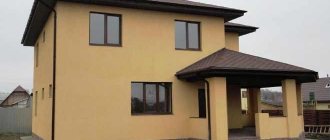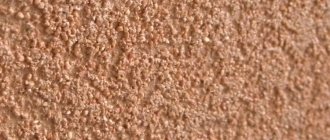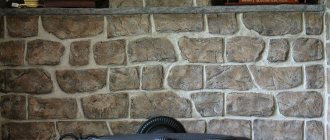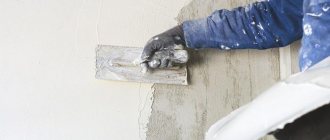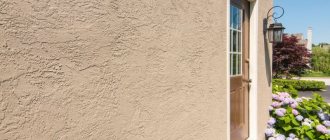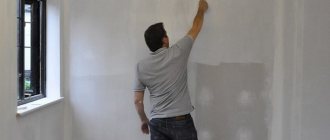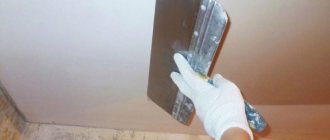When choosing the type of exterior finishing, they often turn to the use of facade decorative plaster.
The reasons for this preference are:
- The ability to create an artistic surface that emphasizes the aesthetic appearance of the building.
- A durable protective layer is applied that can protect wall materials from atmospheric influences and temperature.
- A lot of additional materials are not required, as is the case when finishing with siding, panels, etc.
- All work can be done independently, without the involvement of expensive specialists.
Such advantages provide reasons for choosing decorative plaster as a finishing material, but do not answer the most important question - which material is most suitable for finishing? The fact is that there are many samples of decorative plaster, created on different bases and having different properties.
From a quality point of view, they are all quite worthy of use for cladding, but several types of coatings are the undisputed leaders. Let's consider one of these materials - silicone decorative plaster.
What is silicone plaster
The complex composition allows the plastic material to be prepared only in the factory. Stores sell a base that has certain characteristics, and the introduction of additional components is the task of the master. Depending on the effect you want to achieve, you can add plant and artificial fibers or stone chips to the composition.
When applied, silicone plaster is very plastic and can not only create a beautiful effect on the surface, but also smooth out minor defects. The composition creates a durable film that provides protection against moisture penetration into building structures, which improves their resistance to external negative influences.
Silicone plaster appeared in the arsenal of finishers relatively recently
On a note!
The material is not static, which prevents dust from settling on surfaces; there is no need to regularly wash the walls once a season. And the color’s resistance to fading allows you not to think about repairs for a long time.
Overview of decorative effects
With the help of silicone plaster it is possible to give the facade originality and presentability. The most commonly used textures are:
- Bark beetle In appearance it resembles tree bark, undermined by bark beetles. With the right shade, you can bring the effect as close as possible to natural material.
- Lamb or fleece. It looks gentle and discreet. The appearance of lamb wool is given by the peculiar curls that form on the surface when properly grouted.
- Fur coat. It features original visual characteristics. The surface is rough, and bold combinations of shades make the façade unique and original.
The addition of natural crumbs to silicone plaster made it possible to bring it as close as possible in appearance to natural materials. It is possible to imitate natural stones, but such decoration is more often used in interior design.
Having appeared quite recently, silicone plaster quickly gained popularity among consumers due to its high quality, reliability and durability, as well as excellent external characteristics.
Using this material, you can give the exterior of a building an attractive appearance, and this can be done easily with your own hands with minimal skills and basic tools.
Technical characteristics and composition
The main advantage of silicone plaster is its plasticity, which makes it possible to apply it to the walls yourself and not involve hired workers. The composition allows you to work with any additives to obtain the desired effect, and the rich color palette will bring to life any design projects with complex tint decoration of different areas.
Technical characteristics of silicone plaster:
- layer density is 1.6-1.86 kg/dm3, but the material is vapor permeable;
- frost resistance of 100 cycles, which gives an increased service life of up to 25 years;
- surface application temperature +5-30°C;
- permissible operation – 50+70°С;
- average material consumption per square meter is 2-5 kg;
- Layer setting time is 24 hours.
Characteristics may vary depending on the purpose of the mixture. For exterior use, potassium glass is added to the composition, which provides frost resistance; for interior walls, the material does not possess these qualities.
Functional additives introduced into emulsified resins can distinguish plaster in terms of technical parameters, purpose and final effect of the finished surface.
Varieties
Manufacturers offer a large selection of ready-made mixtures that do not require dilution or the addition of pigments and have a certain texture after application. You can also buy silicone plaster in the form of a white base, to which you can add the desired color. Such compositions are cheaper, however, they require careful adherence to proportions to achieve the desired color.
By composition
Silicone mixtures are produced for interior and exterior use. When plastering walls inside a house, frost resistance is not needed, so a component such as potassium glass is often excluded from the composition. But antifungal additives are often added to the mixture, which ensure that mold does not spread on the walls when the material is used in damp rooms.
There are universal compositions on sale that have all the qualities necessary for use indoors and on building facades.
By effect
Ready-made mixtures can create different reliefs on the surface after drying or have a smooth texture, but all plaster solutions have a rich color palette, which allows you to bring the design concept to life.
Types of finishing material by effect:
- Venetian - applied in several thin layers and has a smooth surface reminiscent of natural stone or silk;
- bark beetle - it smoothes out wall defects well and has a texture with a large number of small grooves that resemble wood eaten away by these beetles;
- lamb - does not require preliminary leveling of the surface and has a fleece relief;
- stone – contains filler of different fractions, which creates the feeling of marble chips applied to the walls.
Silicone mixtures have several varieties
Attention!
Any of these plasters can hide minor surface defects, except for “Venetian”, which requires a perfectly flat base. The structure of the finished coating depends on the filler, the application method and tool, as well as the skill of the worker.
Based on
The quality of the coating will depend on the material of manufacture. Silicate-silicone decorative plaster is a universal composition that can be used indoors and on facades.
An acrylic-based mixture is less resistant to external influences and is more often used for finishing inside the house. Siloxane plaster has increased resistance to mechanical damage and color fading in the sun, therefore it is often used on facades.
Easy job.
Working with silicone decorative plaster is easy and pleasant. Thanks to its elasticity, the mixture spreads easily. If you choose a solution of the “bark beetle” type, where mineral granules are present, it is important to remember that the layer of material should not be thicker than the diameter of the silicone façade plaster filler particles. This is of particular importance when applying a bark beetle type mixture. If you apply it too generously, the effect of the bug-eaten surface will simply disappear. The second layer of the mixture is applied only after the first has completely dried. The solution is applied using traditional tools - a spatula, a rule, and others. Sometimes more exotic options are used - a broom and steel rods: this allows you to create a more textured surface. The mixture can also be applied by machine using a special device. You just need to make sure when purchasing the mixture that it is suitable for machine application.
Important point: The layer of material must be the same over the entire surface to be finished. This is especially important indoors, where the slightest deviation is more noticeable than in exterior decoration.
Advantages and disadvantages
The ability to be used on almost any surface due to its elasticity, and the non-shrinking coating is used for finishing the walls of both public buildings and residential premises. The material has a lot of advantages of use and subtleties of application that must be taken into account when purchasing.
Advantages of silicone plaster:
- It is not subject to cracks during operation, and the coating is moisture-proof. Silicone plaster is often used when finishing new buildings that have not yet undergone natural shrinkage.
- The layer is vapor-permeable and the material can be used on all substrates without the formation of condensation inside structures. This is especially true when plastering walls made of aerated blocks.
- The mixture is non-toxic, does not emit odors and is not flammable, which means it can be used in children's rooms and living areas.
- Can be applied to mineral wool insulation. For plastering, fine mesh and special primer are used to improve adhesion to the base.
- The coating does not fade in the sun and is widely used for finishing facades.
- The silicone composition is not susceptible to the formation of efflorescence and mold on the surface.
- It has increased resistance to mechanical damage, temperature changes and the effects of humidity compared to other finishing materials of this type.
The disadvantages include the difficult dismantling of the coating, which has excellent adhesion to the base. This is reflected in the service life of 20-25 years, without loss of properties. Also, the material is significantly different in price from analogues on other bases, but this is due to increased strength and good decorative characteristics.
Why is silicone added to plaster compositions?
Silicone is the key binder in plaster. It not only ensures strength and reliability, but also improves other characteristics characteristic of decorative compositions:
- Life time. Silicone increases resistance to negative factors, so this finish will last a long time without changing its external properties. If you need to extend the service life even further, we recommend decorative silicate-silicone plaster, which is more resistant to abrasion.
- Elasticity. Increased plasticity guarantees not only convenient application, but also the elimination of cracking during shrinkage of structures.
- Moisture resistance. The material repels moisture, and this quality makes it possible to self-clean during rain.
- Vapor permeability. The ability to remove vapors to the outside prevents the appearance of condensation and eliminates the development of fungus and mold, so this plaster for exterior use can be used together with mineral wool or polystyrene foam.
- Resistance to the formation of efflorescence on the surface;
- Antiseptic properties make it possible to repel dust and dirt.
An important factor is the ease of application of the mixture, as well as high visual qualities, since with the help of silicone plaster you can create an original textured design.
On what walls can silicone plaster be used?
The coating is used on surfaces made of brick, wood, plasterboard and all porous bases of block structures. If used on new, untreated walls, minimal base preparation is sufficient.
Silicone plaster for interior work will fit perfectly over the old layer, regardless of the basis of manufacture. The exception is surfaces coated with varnish and paint; the microporous structure does not provide good adhesion. But the material can be used on walls sheathed with fiber sheets without coating with protective compounds.
Silicone plasters for facades are intended for all types of surfaces that do not have crumbling fragments and have not been painted.
Important!
When using the material on old walls, it is necessary to inspect, prepare the surface and avoid contact with metal structures.
The use of silicone plaster is allowed for any walls
Where is it used?
Silicone plaster is suitable for use on various surfaces. True, it is better to avoid it on low-porosity and smooth coatings. The mixture does not apply well to an oily or varnish base. Not recommended for use on structures made of alloys and metals. The product is used for concrete structures, products made from wood and brick. Such porous surfaces allow steam to pass through. The product is suitable for objects that have a mineral base that has not been treated with dispersion varnish. Particular attention should be paid to the strength of the structure; the flexibility of the material is not able to preserve the wall from destruction. Working with flimsy structures will not bring results.
Technique for applying silicone plaster
When covering walls manually, you need to take into account the short life cycle of the composition, which does not exceed 2-3 hours. Plastering of facades is often performed using a mechanized method, which provides better coverage and low consumption.
Work on the facade also requires compliance with conditions for normal adhesion of the material to the base. The best time for plastering is considered to be spring or autumn at a temperature of +5-30 ° C and a relative humidity of up to 80%.
When performing work in sunny weather, the surface is shaded with a construction mesh until the coating completely sets. It is also not recommended to carry out work in windy weather: the layer will dry out too quickly on the surface, which will affect the strength and durability of the coating.
Tool
To apply the mixtures manually, use a metal or plastic spatula. The plasticity of the material makes it possible to minimize consumption while maximizing wall coverage, so the mechanized method is often used for application.
To work with silicone plaster you will need:
- a tool for manual mixing, an electric drill with a mixer attachment is suitable;
- trowel, grater, trowel for spreading the mortar onto the wall and leveling it;
- a special spatula to create a bark beetle effect;
- a roller with long pile to create a lambskin relief;
- additional containers for water, rags and sponges.
Special tools for creating surface effects are sold in hardware stores. At the stands you should see what kind of relief can be created using different devices. Many craftsmen use improvised materials to create a unique texture - these are plastic bags, wooden stencils, sponges and fabrics with a rough texture. At the same time, do not forget about scaffolding for working above and personal protective equipment.
Surface preparation
The stages of work depend on the quality of the base, and whether it has been processed. Before applying the mixture, the surface must be clean, free of grease and free of strong potholes. It is enough to cover a new wall with soil 2 times, the composition declared by the manufacturer, which may be different for all types of mixture. After each application stage, the surface must be dried according to the technological cycle.
Preparing the old base for applying plaster:
- Inspect the surface for severe chips and cracks.
- Cleaning peeling areas of old plaster and filling large potholes and defects with cement mortar.
- For old surfaces, you can apply a leveling layer of cheaper materials.
- Rinsing the entire base from efflorescence, greasy stains and fungal infections. Soap solutions or special compounds are used to destroy dirt.
- Primer treatment with 2 layers.
Note!
All stages of work are carried out with the necessary technological breaks for drying the intermediate layers. Before applying the solution to the surface, it must be as dry as possible.
The prepared base must be coated with a primer.
Preparation of the solution
Mixtures are often sold in a basic white color, which is tinted by the consumer. They are completely ready for application, just add color and mix. Also, many manufacturers produce their products completely ready for application in different shades. This eliminates possible errors when diluting and different shades on the wall.
Also, a white base layer is used for application when painting walls is intended.
If, during stirring, the composition thickens and is unsuitable for use, the manufacturer allows it to be diluted with water to the desired consistency, but strictly following the recommendations on the packaging. On average, water consumption is 150-200 ml per 25 kg of solution; after adding, the mixture must be thoroughly mixed until smooth.
Application
To avoid strong differences in color, it is recommended to carry out work in one layer with treatment of the entire wall. An exception is Venetian plaster, which is designed to be applied in several layers.
Throwing the mixture onto the wall begins from the corner; the thickness of the layer depends on the relief of the finished coating, on average it is 2-4 mm. If it is necessary to apply several layers, the previous coating is completely dried at normal temperature and humidity for 24 hours.
The solution is spread onto the wall using a trowel and applied with a spatula or roller. The choice of tool depends on the consistency of the composition, the effect of the finished coating and the manufacturer’s recommendations. The relief is created on wet plaster, 30-60 minutes after application using special tools.
On a note!
The drying time of the solution can vary from 24 to 48 hours, and complete setting with the base is achieved after seven days.
Preparing the surface for plaster
Before starting the actual application of facade plaster, several preparatory operations should be performed.
Required:
- Inspect the surface of the wall for various defects - cracks, potholes, peeling of old plaster, etc.
- The exfoliated areas should be separated, and any cracks found should be “opened” with a spatula so that a high-quality seal can be made.
- Fill all imperfections with putty and carefully level the surface.
- If crumbling areas are found, they should be strengthened with silicone primer, trying to apply it so that it penetrates as deeply as possible into the material. This can be achieved by wetting the material before applying the primer.
- If necessary, apply a leveling layer of ordinary cement plaster to fill any potholes or cracks found.
Surface cleaning
Is it possible to paint silicate plaster with silicone paint?
Additional surface treatment is permissible. Silicone facade paint has good contact with any type of mixture and creates an additional protective coating on the surface, which makes the color more intense and brighter. At the same time, the properties of the plaster and its vapor permeability change.
By covering the surface with silicone facade paint, the finish improves the properties of resistance to water and mechanical damage, which will significantly reduce thermal conductivity. In this case, the layer will stop “breathing”; this is unacceptable on foundations made of aerated concrete blocks. Walls made of other materials will only improve their performance.
Painting the façade with silicone-based compounds allows you to wash the surface with detergents that are unacceptable for use on walls without treatment.
Silicone decorative material of all types is quite easy to apply
This solution is used for the following purposes:
- protecting your home from dirt;
- preventing the appearance of mold or mildew due to high humidity;
- protection of surfaces from cracks and damage;
- preventing damage caused by temperature changes;
- giving the building a more aesthetic appearance.
Facade silicone plasters, which you can buy on our website in Moscow very inexpensively, have all the advantages of acrylic and mineral mixtures, and it is very easy to order and buy them from us. This mixture will retain its strength, firmly adhering to the surface, even in severe frosts, which is why it is used in different regions of the country.
Safety precautions at work
Silicone plaster is non-toxic and does not require special protection methods during application. When working, it is necessary to prevent contact of the material with human mucous membranes: protective glasses will help, and if necessary, you can use a respirator. And also provide craftsmen with reliable scaffolding and safe power tools.
If application work is carried out mechanically, the plastering station should be powered outside the coating area - this will help avoid equipment breakdown and possible injury if the solution gets on exposed wiring and sockets.
Plaster consumption
Before purchasing expensive material, it is necessary to make measurements and calculations of the required quantity. The consumption of plaster depends on the thickness of the layer and the manufacturer’s recommendations.
Once the scope of work has been determined, experts recommend sticking to an average of 3.5 kg per square meter. Taking into account that the ready-made mixture is sold in stores in 25 kg buckets, the packaging is enough for 7-8 square meters. m.
To reduce mortar consumption, builders use a mechanized application method, which allows them to save up to 10% on material. This increases the cost of operating the equipment, but if you master the technique of applying plaster yourself, this can significantly reduce the cost of repair work. Preliminary leveling of the surface with cheaper compositions based on cement or gypsum will also significantly reduce consumption.
Manufacturers and material prices
There are many different companies on the building materials market that produce silicone compounds.
Most popular:
- The company Weber (Vetonit) produces plasters based on silicones and silicates. Available in standard colors of the material, which is convenient for tinting. Application of paint to plaster is possible 24 hours after applying the last layer of plaster. The cost of the material is low, a distinctive feature is the frost resistance of the material.
- The Ceresit company produces conventional compositions interspersed with stone chips. They are used both for cladding facades and indoors. They are also used for thermal insulation of rooms and can be applied to any surface, be it drywall, cement or plaster.
- The Caparol company produces white and transparent mixtures based on silicone. Using this plaster, you can create a matte, smooth or grainy coating, for example, “Bark Beetle” or with an admixture of stone inclusions. This plaster has high strength characteristics.
- The Kreisel company produces plaster that can withstand high humidity and severe frosts. Available in several basic shades with different textures.
A 25 kg bucket of silicone plaster costs on average 2-2.5 thousand rubles. A silicone mixture mixed with stone chips costs 3-3.5 thousand rubles.
Silicone-based plasters are easy to use, they have an attractive appearance, and they also have excellent technical qualities, which has earned them popularity among specialists.
Recommendations for selection
Silicone plaster is one of the most expensive materials of its kind, so before purchasing you need to know the basic rules of choice. A poor-quality mixture can disrupt the functionality of house structures in terms of heat and steam exchange, which threatens the occurrence of pockets of freezing and the formation of mold indoors. The coating has high adhesion to any substrate, and dismantling will lead to high costs not only for a new solution, but also for cleaning and preparing the surface.
Material selection rules:
- Date of manufacture. Most mixtures have a shelf life of 6 months, but retain their properties for a year. When purchasing material, you need to choose an earlier date in advance.
- Manufacturer. When purchasing plaster from an unknown brand, you need to ensure the quality of the product, which must be confirmed by certificates.
- A store. The store should have no doubts about working with famous manufacturers. Construction markets often sell low-quality products.
- Before applying the expensive mixture, you must carefully go through all stages of preparatory work. This will affect the final result.
- If the finishing does not involve a combination of different shades on the surface, you should pay attention to ready-made mixtures in color. When tinting yourself, you can easily make a mistake with the quantity, and the difference will already appear on the wall, which threatens additional coloring of the surface.
- When carrying out preparatory work and treating walls with soil, you must adhere to the manufacturer’s recommendations for choosing a material. The manufacturer also prescribes on the packaging which color is best to color the plaster.
External application involves purchasing a composition with frost-resistant characteristics
Fact!
Eliminating mistakes when choosing a material will help you avoid unnecessary expenses on dismantling the old coating and purchasing a new mixture or paint composition.
Manufacturers and cost
Many buyers base their choice of plaster on price, however, this is a mistake. Modern manufacturers often use new technologies, which can reduce the cost of the mixture, but the composition remains unchanged.
The leaders in the construction market can be recognized as the products of Ceresit and Bolars, which have proven themselves to be of high quality and at an affordable price. Manufacturers produce color mixtures in 500 shades and in a white base with different fillers to create effects. The cost of a 25 kg bucket of composition varies within 2 thousand rubles.
Among the imported manufacturers, builders highlight Baumit, Caparol and Weber. These companies provide a guarantee for their products for more than 20 years and produce different mixtures in a rich color palette. The cost of packaging the mixture varies between 3-6 thousand rubles.
It is worth paying attention to modern Russian manufacturers who produce their products in small batches, but with decent quality and at an affordable price. The cost of the material largely depends on the versatility of application and the final surface effect, as well as the brand of the manufacturer.
Caring for silicone plaster
The coating has negative static properties, which does not allow dirt and dust to settle on the walls, therefore it is often used when finishing the facades of high-rise buildings.
If necessary, the surface can be washed with running water with low pressure and rubbed with a soft brush in hard-to-reach places. The manufacturer recommends using water no more than twice a year. For severe contamination, use neutral detergents.
When using plaster on walls inside the house, the coating can be washed with mild detergents using fabrics and sponges. If the plaster has been painted, then it is permissible to use more complex cleaning compounds.
Experts do not recommend contacting a clearing service for cleaning facade walls, which carries out work with high water pressure. Silicone plaster is a durable coating, but if it is regularly subjected to such loads, it may begin to lag behind the base.
Water jetting can have a detrimental effect on plaster.
A long service life and preservation of the original appearance make this type of finishing the most popular in the design of facades and walls indoors. A wide selection of colors and textures allows you to decorate surfaces beautifully and for a long time, and the resistance of silicone plaster to negative factors means you won’t have to think about repairs for more than 20 years.
Was this information useful to you? Share in the comments!
